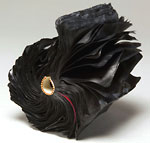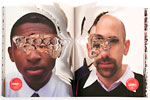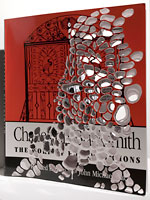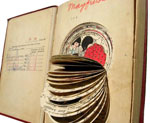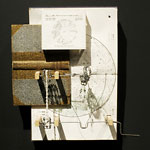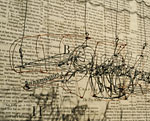Running with Scissors
A Pacific Northwest Museum Lets Artists Go Crazy with Books
By Jonathan Shipley
Casey Curran heaves a raft of books onto the counter at a local used bookstore. Some books on anatomy and the Russo-Japanese war, a volume from The Boxcar Children, one about farming implements. The seller gives Curran a sidelong glance, suspicious, perhaps rightly so, because Curran will go home and cut into them, “destroy” them for his art. “Books aren’t sacred to me,” says the 20-something Seattle resident. “I don’t feel like I’m burning books. In fact, I feel like I might be glorifying them to an extent.”
These glories, as well as works from 12 other internationally-known contemporary artists, are now on display at the Bellevue Arts Museum, just outside Seattle. “The Book Borrowers: Contemporary Artists Transforming the Book,” runs through June 14th. Some 30 works, from artists as far afield as Hawaii, Georgia, Canada and New York City, made the—pardon the pun—cut.
Jennifer Khoshbin, an exhibitor from San Antonio, Texas, gets a little hate mail for destroying books. “It is not the book itself that is of importance,” she says, “it’s the relationship to the book that really matters.” Currently she’s creating music books—vintage texts with small hand cranks that one turns with one’s ear to the book to hear a tune—and small, trophy-sized paper sculptures. “Books are a source of knowledge,” Khoshbin believes, “a fading artifact in today’s society, and a source of nostalgia.”
Is that why artists are turning to the book for inspiration? In this world of Kindles and podcasts, is the book truly going away? Are artists gravitating towards texts now before it’s too late? “No matter how many new technologies people want to have access to in a library,” notes Georgia A. Greeley, a writer, poet, book artist and member of Minnesota’s Center for Book Arts (the largest center of its kind in the nation), “they still want books. They still want to hold them, smell them, turn the pages.”
Book arts—works of art in book form, or books in art form—have been around for hundreds of years; think of the Book of Kells. But Curran’s and Khoshbin’s more direct descendant may be William Blake (1757-1827). Blake and his wife illustrated, printed, colored and bound the Songs of Innocence and of Experience. Self-published and self-distributed, Blake’s book of poems integrated text, image and form. And now here’s Casey Curran with an odd sculpture that incorporates maps, Orwell’s 1984, Huxley’s Brave New World, a crank contraption, and googly-eyed bugs. Is this evolution—or genetic mutation?
Whatever it is, Sandra Krupa has seen it for more than 40 years. The book arts and rare books curator at the University of Washington, she oversees a collection of 15,000 pieces that grows daily. “Artists are using books as a canvas,” she says. The university’s collection attests to that fact. Here are sculptural pieces and cheaply stapled photocopied books; priceless one-of-a-kind pieces and handmade books, all showing the breadth of what a book can be. Some titles poke fun at the whole enterprise: Hydrogen Bums, Caliban’s Books, Tacky Churches, Face to Face with a Fat Man.
‘Books aren’t sacred to me.’
At the San Francisco Center for the Book that definition is also redrawn constantly. “The viewing process asks us to bring ‘visual literacy’ as well as our knowledge of life experience,” notes executive director Dyana Curreri-Ermatinger, “not just an understanding of words and their meaning. Hence the engagement with a work of book art can be richer and deeper than just reading text from a page.”
Engagement is what the Bellevue Arts Museum hopes to achieve among those who attend the exhibition. And who knows? Some viewers might be inspired to go home and read a book, or at least chop one up.









